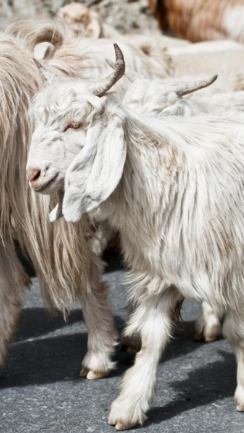Cashmere is King
Imagine walking into a department store at the turn of the fall season. You catch the eye of the most comfortable, soft, amazing sweater. You've instantly fallen in love and then you glance at the price tag. Yikes! "Seriously", you think to yourself "$200 for a sweater?" You then frantically search for the manufacturers tag and read '100% cashmere'. Suddenly you see lights flashing and quickly realize that it's the light bulbs in your head. You slowly understand why it is so expensive, and maybe you cry a little. I have always wondered how cashmere was discovered. Why does it feel so amazing?
These kinds of stories may not be so important to some, but are what fascinate my mind and fill my soul with style.
Did you know the clothing industry produces 9,000-10,000 tons of cashmere each year? Yes, I said tons! When you hear the story it will blow your mind. We are talking about the industrial revolution and middle eastern royalty. Cashmere was originally made for a king!
This weeks style story is brought to you by cashmere, and House of Style Stories.
Cashmere by definition is the fine, downy wool at the roots of hair on a Kashmir goat. Yes that's right goats produce cashmere wool in their coats. Kashmir is a country in southwest Asia and adjacent to India, Pakistan, and Tibet.
There have been disputes over its sovereignty dating back to 1947. The actual word cashmere was founded around 1815-1825.
Check out this cashmere goat, regal is all I have to say!
The story of cashmere began in the 14th-century when a man named Mr Sayyid Ali came to Kashmir. He stumbled upon the town of Ladakh ,which is a very sparse region of Kashmir ,and discovered a large amount of cashmere goats. He loved the soft wool the goats produced and made a pair of socks for the king of Kashmir. After presenting the gift, he suggested that they begin a shawl weaving industry in Kashmir using the cashmere wool. The king liked his idea and soon they began an industry that quickly became a booming business.
When did Cashmere make it's way into the US?
In the 18th and early 19th centuries, Kashmir refined cashmere shawl production through an industry from goat down imported through Ladakh. The down trade was controlled by treaties signed as a result of previous wars. The shawls were introduced into Western Europe when the General Chief of the French campaign in Egypt (1799–1802) sent one to Paris.
The shawl's arrival created an immediate sensation and plans were put in place to start manufacturing the product in France.
Austrian Textile Manufacturer Bernhard Altmann is credited with bringing cashmere to America on a mass scale beginning in 1947.
Soon after it's entry into Europe, the United States began production in Massachusetts and became a major contributor to the American Industrial Revolution.
The town of Uxbridge, Massachusetts became an early textile center in the Blackstone Valley, which was known for the manufacturing of cashmere wool.
Is a Pashmina Cashmere? The short answer is no. The long answer, is a fiber known as "pashm" (Persian for wool) or pashmina (Persian/Urdu word derived from pashm) for its use in the handmade shawls of Kashmir. References to woolen shawls appear in texts surviving from between the 3rd century BC and the 11th century AD. Pashmina is often used interchangeably with shawl, however "pashmina" refers to the type of wool (silk blend).
Why Invest in Cashmere? It takes approximately a year’s worth of wool from three to four goats to make a woman’s single ply cashmere sweater. Cashmere is eight times warmer than sheep’s wool and 33% lighter in weight. Cashmere fiber has a crimp or curl that sheep’s wool does not have. This extra crimp holds pockets of warm air close to the body. It is the softest animal fiber available that is measureable by its low micron count. The micron count is the measure of the diameter of the fiber.
The lower the number, the softer the fiber. The finest cashmere has a micron count of 16 or less. Cashmere is as regal as it's history. So, the next time you walk into a store and before you have a "fashion freak out session". Take a moment to think of the King of Kashmir and his fancy socks. Pick out the best color and give that cashmere sweater a good home!












